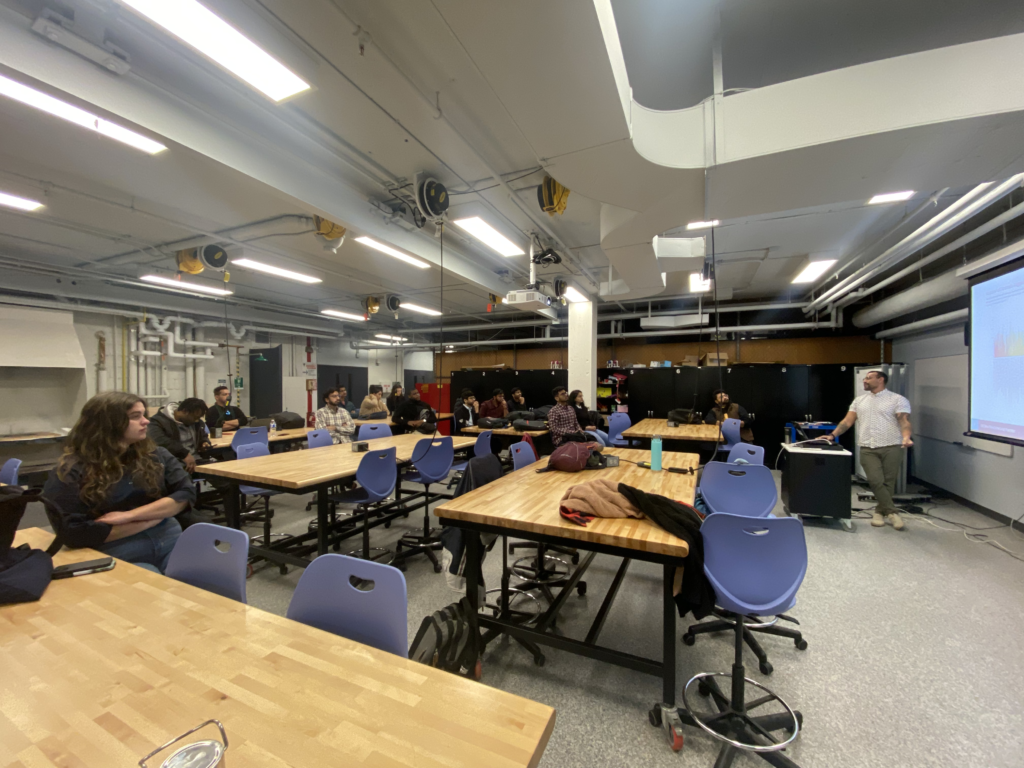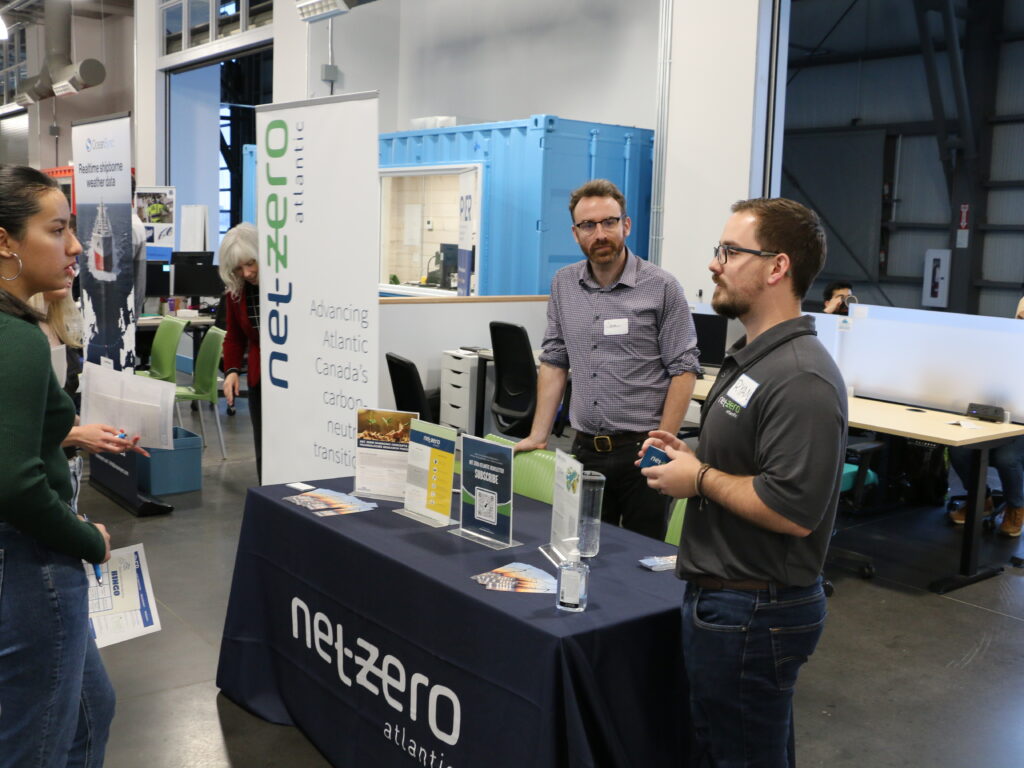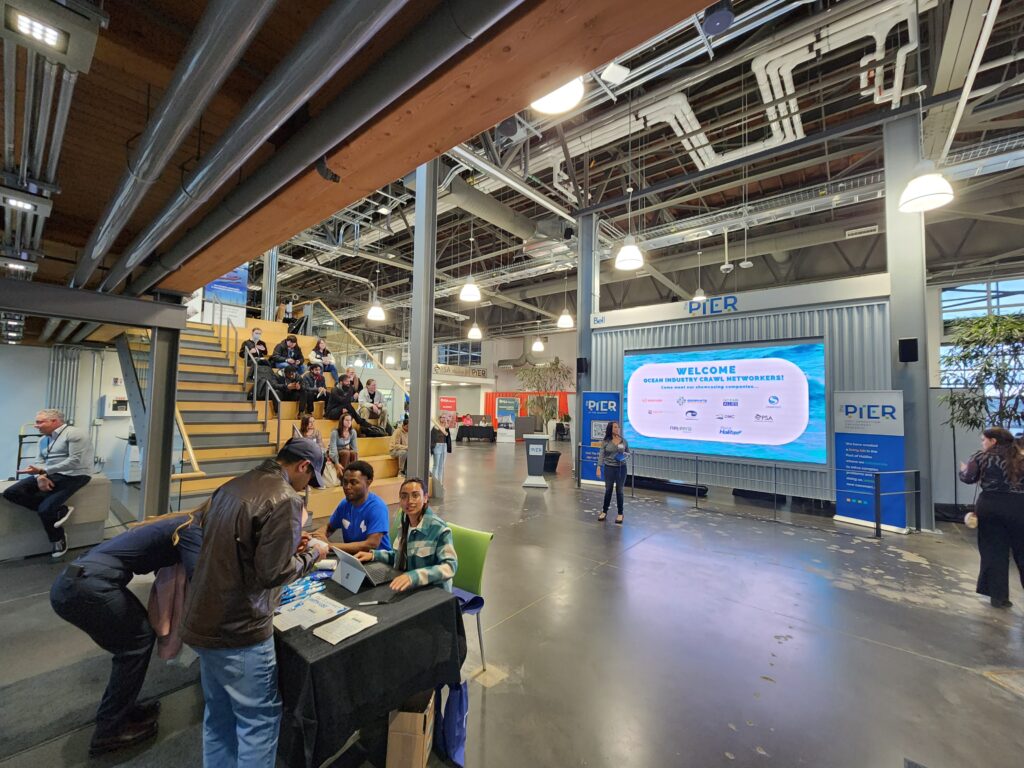On November 17th DeepSense teamed up with SURGE Innovation, Centre for Ocean Ventures and Entrepreneurship (COVE), SEATAC, Nova Scotia Community College (NSCC), Ocean Technology Council of Nova Scotia (OTCNS), and the Port Innovation Engagement Research (PIER) to host the first-ever Ocean Industry Crawl. The idea was to introduce students to the ocean technology sector in Atlantic Canada by showcasing research and industry in the Halifax Regional Municipality.
Students hopped on a bus for an afternoon that was filled with insightful conversations and learning about the blue economy in Atlantic Canada with visits to Dalhousie’s Aquatron Laboratory, Ocean Tracking Network (OTN), COVE, and NSCC Ivany campus.
Reaching Students Across All Programs
“There is so much innovative work happening in the ocean sector in Atlantic Canada and so many opportunities for students right here in the HRM, but not many think you need a background in marine biology or oceanography and that’s not the case at all,” says DeepSense Executive Director (Acting), Lucija Prelovec.“We specifically wanted students not in those fields to join our crawl and see that there is opportunity for them to grow their careers in the ocean sector in Halifax.”
The crawl brought students from Marine Biology, Applied Computer Science, Ocean Sciences, Digital Innovation, Marine Management, Mechanical Engineering Technology, and many more programs together to learn about the ocean sector together.
“I was so glad to see students from a variety of post-secondary programs joining us for this event,” says Janine Meade, the Business Development Lead at SEATAC. “Many people working in the ocean sector have professional or educational backgrounds that don’t seem ocean related,” Meade explains. “ – In reality, the ocean sector needs people with skills in IT, marketing, business administration.”
Students were blown away by the opportunities they saw, “The crawl provided first-hand expertise from a variety of organizations that are passionate about solving unanswered questions and tackling problems in our oceans using research, data, and developing new technologies.” says Samantha Best, a Database Administration Student at NSCC. The ocean sector is often overlooked as an industry with opportunities for IT students, computer science students, and those with more technical skills. The crawl provided opportunities for students across all programs to learn about options in the ocean technology industry, expanding their career horizons. “Growing up in Nova Scotia, this event opened my eyes to the importance of becoming involved in learning how to sustain our ocean environment and provided insight on opportunities available to make a difference for our future,” says Best.

First Stop: Dalhousie Aquatron & Ocean Tracking Network
The students started off their day at the Dalhousie Aquatron, where they were shown around the various tanks in the facility, which included the large Pool Tank, the facility’s other large tanks currently housing more than 1500 trout, as well as the chance to venture into the many wet labs situated within the facility where researchers and students within the Faculty of Science are conducting various projects on a wide range of subjects, including algae and sea cucumbers
Their next stop was the Ocean Tracking Network (OTN), a global aquatic research, data management and partnership platform based out of at Dalhousie University. The students were given a live demonstration of some of the equipment that OTN uses in the field, including their prized Falcon remotely operated vehicle (ROV), which has allowed the OTN to venture into new depths and study more. “My standout moment from the Ocean Crawl was operating the Seaeye Falcon ROV at Dalhousie University’s Ocean Tracking Network. Experiencing its thrusters and cameras and witnessing its potential in recovering lost tracking equipment in deep-water habitats was incredibly impactful,” says Kamal Kumar, Master of Computer Science Student at Dalhousie University. “The cutting-edge technologies driving ocean exploration forward left me genuinely inspired for the industry’s exciting future.”
Second Stop: Visiting COVE
The crawl continued in Dartmouth, visiting COVE, an innovation hub that connects resources, people, and ideas to drive solutions and growth in Canada’s blue economy. Students had the opportunity to learn about COVE and their internship program and tour the facility where they were joined by two of COVE’s partners, Precise Design and Dartmouth Ocean Technologies. COVE CEO, Melanie Nadeau explains why it was important to include COVE as a stop on the crawl, “having students see the ocean differently starts with meeting the people who work behind the scenes on various technologies,” says Melanie Nadeau. “The Ocean Industry Crawl is a perfect conduit to build connections. Introducing post-secondary students to COVE and meeting the brightest minds in the sector provides an opportunity to share innovative solutions in support of a sustainable ocean economy,” says Nadeau.
The students heard all about Stella Maris, COVE’s unique testbed for marine instrumentation. With a subsea platform, dockside testing area, shoreside operations center, and 24-hour access to the data portal, Stella Maris Testing Solution offers everything a marine technology company needs to conduct product development, verification, and commercialization to advance innovation. Stella Maris Testing Solution supports a range of sensor types, such as acoustic, optical, chemical, and biological.
Third Stop: NSCC Ivany
The next stop on the crawl was Nova Scotia’s Community College (NSCC) Ivany campus, where the students were given a tour of both the Ocean Technology workshop as well as SEATAC’s space on the NSCC Ivany campus. Students were able to engage with both instructors and students from the Ocean Technology program as well as who gave them demonstrations of the various projects that they were working on. The Ocean Technology program is a graduate certificate program that equips students with the skills to work in the growing field of ocean technology, created in response to industry expressing a need for technically skilled professionals with experience on the ocean. The students also toured NSCC’s Design and Innovation Centre, one of many research facilities within NSCC where industry and entrepreneurs work with researchers, engineers and students to design and build tailored prototypes and automated processes.

Ocean Industry Networking Event with The PIER
The day ended at the PIER, where more students joined for an evening of connecting with companies in the ocean industry. The PIER provides a space for ocean technology companies to develop solutions, interact directly with end users, receive actionable insights, and to work alongside global industry leaders. Students had the chance to talk with OMC, PSA Halifax, Graphite Innovation & Technologies, Oceansync, Ocean Allies, GeoSpectrum Technologies, Net Zero Atlantic, Halifax Port Authority, and Datifex.
“Experiences like the Ocean Industry crawl are a creative and engaging way to expose students from a broad range of disciplines to the technology industry. Students were able to see how technology can play a key role in decarbonizing the broader ocean industry,” said Dr. Sherry Scully, the Director of Workforce Development at The PIER. “The event also helped us to demonstrate that there are both traditional and non-traditional pathways for young and diverse talent to enter these sectors.”
Till Next Time
The crawl received rave reviews from students and industry involved. In the post-crawl survey, students said, “it was honestly such a great experience. It was so interesting to learn about the variety of organizations in our area, different technologies and solutions that are developed in Nova Scotia for our oceans and economy, and opened myself up to a whole new network of individuals that are passionate about the work they do and genuinely interested in teaching us as much as we wanted to know. It was a 10/10 experience. Thank you so much!”
Plans are in place to make the Ocean Industry Crawl an annual event as watching students connect with ocean technology companies and seeing them build their networks in the blue economy is an invaluable experience. Similar thoughts shared with mentors from the crawl, Iago Gradin, Field Technician with Ocean Tracking Network says, “events such as the Ocean Crawl are extremely important to expose the students to the variety of career paths available after completing a university or college program. The ocean sector in Halifax is rapidly growing and the need for qualified and skilled personnel is in extremely high demand.”
Thank you to the organizing partners STEM Connector, DeepSense, NSCC, COVE, The PIER, SURGE, SEATAC and NSCC. Thank you to the funding partners, OTCNS, PIER, DeepSense, SURGE, and Business + Higher Education Roundtable. Thank you to the companies who took the time to speak with the students, OTN, Dalhousie University, COVE, Precise Design, Dartmouth Ocean Technologies, NSCC Ivany, OMC, PSA Halifax, Graphite Innovation & Technologies, Oceansync, Ocean Allies, GeoSpectrum Technologies, Net Zero Atlantic, Halifax Port Authority, and Datifex.
Stay tuned for the next Ocean Industry Crawl!

